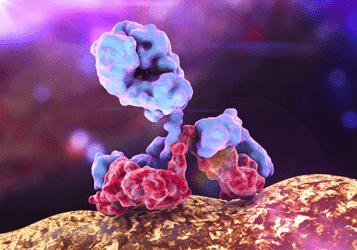- Home
- Products
- Customized ADCs
- FOLH1
- Anti-FOLH1-Mc-MMAF ADC
Anti-FOLH1-Mc-MMAF ADC (CAT#: ADC-W-158)
This ADC product is comprised of an anti-FOLH1 monoclonal antibody conjugated via a Mc linker to MMAF. The MMAF is targeted to certain cancers by immunerecognition and delivered into cancer cells via receptor mediated endocytosis. Within the cell, MMAF binds to tubulins, interrupts microtubule dynamics, and subsequently, induces cell death.
- ADC Target
- ADC Antibody
- ADC Linker
- ADC payload drug
- Name
- FOLH1
- Alternative Names
- FOLH1; folate hydrolase (prostate-specific membrane antigen) 1; PSM; FGCP; FOLH; GCP2; PSMA; mGCP; GCPII; NAALAD1; NAALAdase; glutamate carboxypeptidase 2; NAALADase I; glutamate carboxylase II; glutamate carboxypeptidase II; membrane glutamate carboxypep
- Target Entrez Gene ID
- 2346
- Target UniProt ID
- Q04609
- Overview
- This gene encodes a type II transmembrane glycoprotein belonging to the M28 peptidase family. The protein acts as a glutamate carboxypeptidase on different alternative substrates, including the nutrient folate and the neuropeptide N-acetyl-l-aspartyl-l-glutamate and is expressed in a number of tissues such as prostate, central and peripheral nervous system and kidney. A mutation in this gene may be associated with impaired intestinal absorption of dietary folates, resulting in low blood folate levels and consequent hyperhomocysteinemia. Expression of this protein in the brain may be involved in a number of pathological conditions associated with glutamate excitotoxicity. In the prostate the protein is up-regulated in cancerous cells and is used as an effective diagnostic and prognostic indicator of prostate cancer. This gene likely arose from a duplication event of a nearby chromosomal region. Alternative splicing gives rise to multiple transcript variants encoding several different isoforms.
- Overview
- Anti-FOLH1 antibody
- Name
- Mc (maleimidocaproyl)
- Description
- Noncleavable linkers, is considered noncleavable-meaning linker cleavage, and payload release does not depend on the differential properties between the plasma and some cytoplasmic compartments. Instead, the release of the cytotoxic drug is postulated to occur after internalization of the ADC via antigen-mediated endocytosis and delivery to lysosomal compartment, where the antibody is degraded to the level of amino acids through intracellular proteolytic degradation.
- Name
- MMAF (Monomethyl auristatin F)
- Description
- Derived from Auristatin,are water-soluble dolastatin analogs of dolastatin 10. Dolastatin 10 belongs to dolastatin family and it can powerfully bind to tubulin, thus inhibiting polymerization mediated through the binding to the vinca alkaloid binding domain, and causes cell to accumulate in metaphase arrest.
For Research Use Only. NOT FOR CLINICAL USE.
Related Products
- Anti-CD70-β-glucuronide-MMAE ADC-5 (CAT#: ADC-W-374)
- Anti-CD22 (Bectumomab)-SMCC-DM1 ADC (CAT#: ADC-W-794)
- Anti-ERBB2 (Trastuzumab-LC-N152)-DBCO-MMAF ADC (CAT#: ADC-W-255)
- Anti-FLT1 (Icrucumab)-MC-Vc-PAB-DMEA-(PEG2)-duocarmycin SA ADC (CAT#: ADC-W-1153)
- Anti-IL17A (Secukinumab)-MC-Vc-PAB-DMEA-(PEG2)-duocarmycin SA ADC (CAT#: ADC-W-1315)
- Anti-STEAP-1-Mc-MMAF ADC-2 (CAT#: ADC-W-146)
- Anti-CD5 (Zolimomab aritox)-SPDB-DM4 ADC (CAT#: ADC-W-927)
- Anti-DLL4 (Demcizumab)-MC-MMAF ADC (CAT#: ADC-W-1018)
- Anti-RSV (Felvizumab)-SPDB-DM4 ADC (CAT#: ADC-W-2001)
- Anti-CD80 (Galiximab)-SPDB-DM4 ADC (CAT#: ADC-W-957)
Published Data
+ Submit Publications

Scientific Resources
Customer Reviews and FAQs
There are currently no Customer reviews or questions for ADC-W-158. Click the button above to contact us or submit your feedback about this product.
Quick Links
Other Products
Same Target
Same Linker
Same Payload
| CAT# | Product Name | Linker | Payload |
| ADC-W-1160 | Anti-FOLH1 (Capromab)-SMCC-DM1 ADC | SMCC (N-succinimidyl 4-(Nmaleimidomethyl)cyclohexane-1-carboxylate) | DM1 (N2'-Deacetyl-N2'-(3-mercapto-1-oxopropyl)maytansine) |
| ADC-W-1163 | Anti-FOLH1 (Capromab)-MC-Vc-PAB-MMAE ADC | MC-Vc-PAB (maleimidocaproyl-valine-citrulline-p-aminobenzoyloxycarbonyl) | MMAE |
| ADC-W-157 | Anti-FOLH1-VC-MMAF ADC | VC (valine-citrulline) | MMAF (Monomethyl auristatin F) |
| ADC-W-118 | Anti-FOLH1-cytotoxin Compound A ADC-1 | cytotoxin Compound A | |
| ADC-W-156 | Anti-FOLH1-Mc-VC-PABC-MMAE ADC | MC-VC-PABC (maleimidocaproyl-valine-citrulline-p-aminobenzoyloxycarbonyl) | MMAE (Monomethyl auristatin E) |
| CAT# | Product Name | Linker | Payload |
| ADC-W-515 | Anti-EGFR-Mc-MMAF ADC-5 | Mc (maleimidocaproyl) | MMAF (Monomethyl auristatin F) |
| ADC-W-2622 | Anti-NCAM1 (Lorvotuzumab )-MC-MMAF ADC | MC (maleimidocaproyl) | MMAF |
| ADC-W-485 | Anti-EphA2-Mc-MMAF ADC-1 | Mc (maleimidocaproyl) | MMAF (Monomethyl auristatin F) |
| ADC-W-322 | Anti-CD19-Mc-MMAF ADC-1 | Mc (maleimidocaproyl) | MMAF (Monomethyl auristatin F) |
| ADC-W-114 | Anti-CD33-Mc-MMAF ADC-3 | Mc (maleimidocaproyl) | MMAF (Monomethyl auristatin F) |
| CAT# | Product Name | Linker | Payload |
| ADC-W-491 | Anti-TNFRSF17-Mc-MMAF ADC | Mc (maleimidocaproyl) | MMAF (Monomethyl auristatin F) |
| ADC-W-493 | Anti-CD19-Mc-MMAF ADC-3 | Mc (maleimidocaproyl) | MMAF (Monomethyl auristatin F) |
| ADC-W-537 | Anti-TPBG-Mc-MMAF ADC | Mc (maleimidocaproyl) | MMAF (Monomethyl auristatin F) |
| ADC-AA-010 | anti-HIgG(Fc)Fab-C-MMAF ADC | Cleavable linkers | MMAF (Monomethyl auristatin F) |
| ADC-AA-009 | anti-HIgG(Fc)Fab-N-MMAF ADC | Noncleavable linkers | MMAF (Monomethyl auristatin F) |
Online Inquiry
Welcome! For price inquiries, please feel free to contact us through the form on the left side. We will get back to you as soon as possible.



